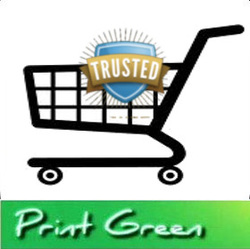 In our today's Economy, probably most laser printer users, not only those individual owners but also some offices and businesses, would prefer online retailers for getting supplies. Practically it is acceptable, first you not only get discounts and privileges, second there's an extensive cut in your printing expense that is certainly noticeable. Another factor why most consumers prefer online retailers is that, they can compare prices as well as the amount they can possibly save, up front. Instead of the idea to stroll around the streets, look for a retail shop or direct seller, and see which one has a good offer to fit your budget. Ideally, we all want to save, hence if ever there's a possible way which can aid on cutting down any expense, we will certainly go for it. Original printer supplies such as branded ink and toner cartridges are highly expensive, and customers can't do nothing as of the moment to partially take the price down. Due to this fact, alternatives are getting the spotlight and taking all the credits from the consumers who were satisfied for what it can provide. While it's inevitable to experience minor issues with a printer that uses compatible cartridges, this problem can actually happen the same with OEMs. The quality specifically the output of a printer that used original cartridges is way better over the alternatives. However, there are cases from which these low-cost consumables have delivered printout quality of par with high-price cartridges. These instances led to a long argument that debates which among these two consumables is the ideal.Whichever brand or manufacturer you're side may be, it wouldn't compromise your loyalty to them if you use remanufactured cartridges. Canon and HP are two of the most competing printer manufacturers in the Print Industry, along with a few, but even these major companies do recycle their products. The purpose of their recycling programs is mainly to reuse the materials and components of their used products. This results to the production of eco-friendly toner cartridges and ink cartridges which aids to the sustainability and preservation of resources which are use to manufacture new printer consumables.To achieve a completely zero-waste landfill is a bit skeptical considering the industry's situation right now. Nevertheless, we should be more practical with our printing practices, besides it's part of our essential responsibility for the environment.
 In United States there are such laws that prohibit printer manufacturers to void the warranty of the machine where recycled toner cartridges are being used. For areas which are protected by such federal laws, they are fortunate to be able to break their expenses particularly in printing. The use of recycled printer consumables provide significant savings and more importantly it protects the environment through reusing processed materials. Just like any existing matter, all the components of a printer cartridge may wear off in time, that is why there's a certain limit to which a piece of cartridge can be recycled. It depends on the condition of the cartridge itself whether how many times it can be reused, more likely 3 times is the minimum. I wonder how the manufacturers know the approximate number of times a cartridge has been recycled, perhaps there's a mark. If you think refilling your own cartridges is considered a recycling process as well, in a way yes it is. But the real recycling process doesn't only involve refilling the tanks, it goes a long way. Refilling the cartridge by yourself has a higher tendency of getting a defective one. Also, if you inject enough ink into the tank then it failed to work properly, in the end you only waste the ink, your money, as well as the cartridge which might be more useful if you let someone knowledgeable do it. Unlike if you sent it to your respective retailer which has a cartridge return program, that cartridge you've wasted might have found a new life. Cartridge recycling or any form of recycling stretches the useful life of a certain product, as well as the materials and components that it comprises. Although the print quality may not be as good as with OEM cartridges, the cut in price plus the environmental benefits that it provide are good trade-off. In addition, cost is not the primary factor to consider when determining the best quality. Remember that what matter is how you print, not by how much have you spent for it.
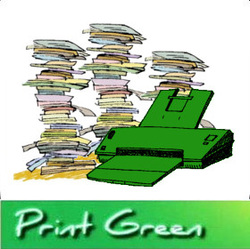 Do you want to save with your printer's mounting expenses? The fact that most manufacturers are selling highly expensive printing supplies, it can be hard to cut down the cost. In most cases, users opt to decrease their consumption of supplies and reduce their volume of printing just to at least moderate the generated expense. In our today's world, options are abundantly available, and we just need to consider trying them to find out how can they be useful for our problem. Quit asking if there's such a way to set yourself free from those pricey printer consumables. Indeed there's a way, and one good example to cite with are the replacement cartridges or the so called remanufactured cartridges. These consumables are made from OEM components of empty or used cartridges, hence they can still be tagged as original.Through using remanufactured toner cartridges and ink cartridges, you can greatly shrink your printer's recurrent expense by almost half of the previous months where you used OEMs. Remanufactured printer cartridges come with the word cheap or substandard. Yes these products are substantially cheap but they're not substandard. Fraud manufacturers are fishing for easy money, they're the ones responsible why people connotes the term 'substandard' when they heard of remanufactured cartridges. Many printers now support economy mode of printing, but how can this feature be useful to reduce overall expense? Let's say your printing drafts or test pages, you think it's efficient in your part to print in regular settings when you can use eco-mode? Basically, what it does is to prevent the printer from using excessive ink/toner with every print. Text output may somewhat fall into gray-scale quality but still readable, unless you need a hard copy for an important purpose just turn the eco-mode off. Another way to reduce printing cost particularly with the supplies, is by fitting two pages in a single sheet or try duplexing, a feature that allows printing on both sides of a page. First you make a cut on the expense or purchasing paper materials, second, you get to reserved more inks since printing two files in a single paper tend to shrink the output. As a rule of thumb, if you don't intend to use the printer for photo printing, graphics or high resolution prints, it is wise to have a laser printer instead. Laser toner cartridges have a considerably low cost-per-page, that's for original brands. What more if you try using the remans which are half the price cheaper compared to branded supplies.
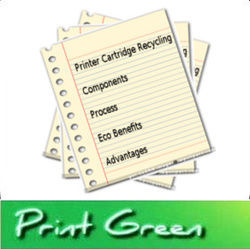 To learn more about the topic, talk about it. That's why instead of asking everyone to do their part and be one with the environmentally responsible citizen around the world, I'll be providing must known facts about printer cartridges recycling. Printer consumables such as the ink and toner cartridges, even the drum unit, for a business that requires printing on a daily basis these supplies may generate a totally huge cost. Not all that, once these items reached their end of life or usage limit, there are two paths from which they could probably end up, it's either on the recycling plants or landfills. Although there are programs and agencies that promote proper e-waste disposal, still a certain percentage of such waste materials Cartridges components consist of plastic, metal, rubber, paper and foam. About 80% of it composed plastic and metal, the remaining percentage are the other components. There are two types of printer cartridges, one is the ink cartridge and the other is the toner cartridge, say if you include it on the overall components that made up a cartridge, nearly 97% of a cartridge's components can be recycled.The recycling process that a printer cartridge go through is not similar to the ones you commonly know. In general, it involves cleaning, refurbishing, segregating, drilling, and refilling, something more like that. Even the recycling process that each manufacturer used must be certified by the print industry standards in order to prevent substandard products from disseminating in the market.Economically speaking, recycled toner cartridges and ink cartridges only cost 50% less than branded supplies. The significant cost reduction doesn't mean these printer consumables are of bad quality. Remember that they're made of recycled components from original cartridges, hence the manufacturer doesn't use raw materials in the production process. Cartridge recycling also require less energy consumption which makes recycled products more affordable.Years ago, millions or even billions of printer cartridges are being dumped in the landfills and incinerators. After they developed the right method of cartridge recycling, eventually the number of printer supplies that undergo recycling increased over time. Thus, more consumers are gradually accepting the market for recycled toner cartridges and ink cartridges from which aside from the fact that they save money through using it, they also aid on sustainability.
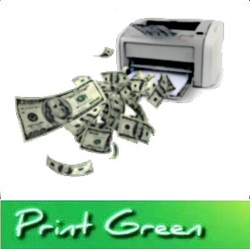 It's practical to think before you do anything else. Unless you don't belong to that type of person, guess it would be better to consider changing some irregular habits. Same with printing practices, in order to cut down expenses a strategy can be considered a good plan to break some old records. To minimize printing expenses due to high priced consumables such as ink cartridges and toner cartridges, plus the electricity a machine consumes during its operation, there are easy ways to consider. Printer consumables are resources that you can't avoid to buy for your machine, so instead of eliminating them which is actually not possible, find a way to shrink the need to frequently buy a new one. Less consumption means less demand, right? Before you get to print anything, think if it's really important for you to have a hard copy of it. If yes, recheck the file for any errors or anything that might cause you to reprint it. Doing so will prevent wasting ink/toner consumables, paper materials and electricity. Send it through email and not as a printed copy. As much as you can attached a file or image in an email, do so, instead of printing it then carrying or sending it to the receiver. If you can practice this, you can eliminate hassles and more of it, and noticed that you don't have to use your printer just to let someone have its own copy. Same thing applies on you, carrying bulky files and documents like office papers and reports, that's old school, try saving your files in a storage device then just view it using a PC, laptop or projector anytime you need. If it's really required to have a hard copy then go have it printed, but make sure you wouldn't end up having piles of draft copies and test pages. Again think before you print. Ask yourself, are all these pages need to be printed, does it need to be in full color copy or just plain black, should you include the page numbers and footers or probably not? Those are just my examples, you can have a lot of questions to ask yourself before hitting the print button. Well of course there are instances that a file composes of several pages, and you have no choice but to print all of it, then a good suggestion is to consider using compatible cartridges. These replacement cartridges are not substandard, major printer manufacturers recycle their own products, so what's the reason you shouldn't opt for it? Using remanufactured toner cartridges and ink cartridges, or often called recycled printer consumables, won't harm your printer. Take note that using an original cartridge from a branded manufacturer may result to print errors just as using compatibles.
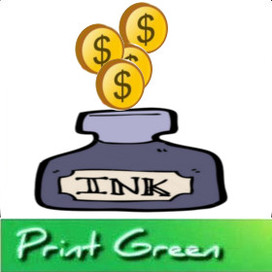 To many, switching to green printing practices means saving money, but to some people who are environmentally concern, it isn't just saving but helping the environment as well. Businesses and consumers are both getting benefits in the process, and it's very useful in the user's end for they get what they need with the same value for almost half the price. Green printing practices may start even at the the time you will buy a printer. It's not only the way you print that matters, more importantly you should also pay attention to the machine that you're using. Is it rated with Energy Star, or certified for energy efficiency? U.S. Environmental Protection Agency or EPA provides guidelines and metrics that aren't that high to consider for a printer not to pass. To make it more simple, while choosing a printer just ask the tech guy in charge of assisting you, ask about the energy usage and efficiency of a particular model you want.Most high-end printer models in the market nowadays are typically with features and functionality that are not just energy or cost efficient, but are eco-friendly as well. Some good features include : Duplex (double-sided) printing, which is needless to explain why it's an effective feature, Eco-mode and Sleep-mode are also excellent. Additionally, using high-capacity printer cartridges may reduce cost-per-page with every print. Xerox ink blocks for ColorQube printers are unique and ideal to consider. If you really want to save more while aiding in the sustainability and environment protection. Switch to using eco-friendly toner cartridges and ink cartridges for your printer. These printer consumables are commonly available in the market in bargain prices. The big names in print industry also recycle their supplies and products, so how can you say recycled printer cartridges are substandard? It's not always on the brand or model or price that quality can be measured, it's on the way you print.
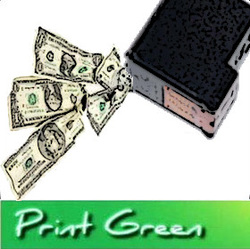 It's quite unusual to see an office or any working environment not to have any printing machine, or even a stand-alone copier, fax and scanner. Actually even an individual who works at home requires such devices. Honestly these devices are the fruits of technology which became widely popular due to the fact that most offices and professionals needs a printing machine. However, these printers require consumables such as toner and ink cartridges which harm the environment. Of course we can't just eliminate printers and other electronic devices just in order to get rid of their consumables. What will happen if we forbid people to use such machines, how can they be more productive and what can they use to replace it? So to solve the problem with printer consumables, recycling has been applied by several manufacturing companies into their products. Hence, these companies prevent the cartridges from filling up the landfills or worse contaminate the surrounding areas where people dump their wastes.Regardless of how complicated the process there is to recycle a single piece of empty cartridge, its effect is enormously worth it. Considering that the manufacturers don't need to use virgin materials and resources to reproduce products, the amount of energy and natural resources that the process can save may reach up to 80%. If you try to draw it as pie chart, looking at the bigger fraction, it seems like your playing pacman and the 80% space gets to eat the remaining 20%. Kidding aside, sooner or later researchers will find a way or rather a solution to max out the advantage of recycling.Although a few consumers are more concern of saving their hard-earned money rather than the environment, in the process of cartridge recycling manufacturers, consumers and the environment as well are all getting benefits. You know for a fact that cartridge recycling also has a certain limit, and those components which can no longer be recycled are still reuse. If you're not yer participating to any recycling programs or organizations, here's a good thing to consider. Wise consumers doesn't only use recycled toner cartridges and ink cartridges to save money, they also sell them to recycling plants that accept return cartridges for a price. Sounds great isn't it, you get to earn a few bucks while making yourself environmentally responsible.
 Ricoh USA, one of the well-known manufacturers of copier, printer, fax machines scanners and similar machines related to the Print Industry, is not only known for its electronic products but also for its commitment to the environment. Their acts and efforts aren't widely known yet, and it doesn't matter so long as what their doing is noble and aids in sustainability. Ricoh as not everyone knows, is quite impressive to spend roughly $3000 a month for their recycling project which includes collecting used or empty printer toner and ink cartridges. These information are mainly from their recycling facility in Malaysia alone, since I haven't gotten much details about the company's other recycling areas. Additionally, Ricoh also collects unused or worn-out printer equipments, copiers and other electronic devices to ensure that these products are disposed properly and that they wouldn't end up in the landfills. The company's reliable technical supporters are the ones responsible for collecting the printers, copier, etc., from customers who want to dispose it. Instead of just letting those products become land-fillers, they're taking them to Ricoh's recycling plant. Through recycling electronic products, Ricoh was able to manufacture brand new printers and copiers from used components and materials.In addition, RIcoh USA also facilitates several return programs for printer toner cartridges, container and maintenance kit. The company pushes it all by encouraging most of its customers to recycle their printer supplies by participating in any of their return programs. Out of these used supplies, they managed to produce recycled toner cartridges and ink cartridges which reflects the company's environmental responsibility. Mr. Peter Wee, COO of Ricoh Malaysia, mentioned that their company will be focusing on SME (Small and Medium Enterprises). Probably in the mid quarter of this year, there's an expected launching of new laser printers from Ricoh which aims to boost the company's venture in the field of small and medium enterprises.
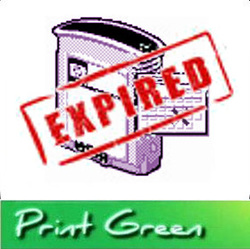 Printer cartridges just like any other consumables in the market also have their own expiry date. Although there are no actual proofs about the harmful effects or disadvantages of using expired printer cartridges, let's just put it this way, an expired food may caused food poison, period. Even if it still looks good to use, it's best not to try it in your printer, unless you'll take all the risk that may result from using it. A printer cartridge's expiration date is visible from its label or packaging so you don't have to worry how you'll know when will it expire. If they will still work or not, I can't give much details as even I haven't tried using an expired ink or toner cartridges. But do you know that even a good as new cartridge may become useless just like an expired one, even if it hasn't reach its expiry? Printers which are not frequently use tend to have clogged ink cartridges or toner build up. If the cartridge inside the machine is left unused tendency is it might end up useless over a period of time. The ink thickens inside the cartridge then eventually turn compact due to chemical changes. Hence a new cartridge should also become as worthless as an expired cartridge if not use regularly. To ensure you won't experienced such problem, better use the cartridges all the way until it deteriorates instead of letting it dried for nothing. On the manufacturer's part, expired printer cartridges means loss in profit. Low consumer demand will result to cartridges supply being stocked on shelves and storage rooms of retailers. It was a nice thing to know that printer cartridges can be recycled, and many manufacturers especially the big names in the print industry recycle their supplies. One thing is for sure, manufacturers, consumers and the environment are all benefiting from recycling printer consumables. Most customers prefer it over OEM since they're much affordable and produce less carbon footprints. These eco-friendly toner cartridges are one of the solutions that may help on reducing ecological effects of technology to the environment. The next time you go shopping for replacement cartridges, check the label and packaging and see the expiration dates. Prefer the ones with longer expiry date so you can still make use of it once the current cartridges in your printer runs out of ink.
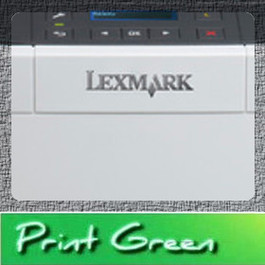 Is it good to hear that Lexmark has already ended their inkjet market and sold the patents to their long-term partner? Honestly it always saddened me to hear such news in the print industry that a company is closing or in a down-slope road. However, considering the fact that less manufacturers means less generated waste, still it has some good points. Actually Lexmark is not really closing its business, but rather just putting an end to their inkjet printing business. The company plans to focus more on its laser printer business and some divisions. On a good note, Funai, their trusted long-time partner in the business of manufacturing inkjet printer acquired 1,500 patents, which means that they can now manufacture their own line of inkjet equipments. On the other hand, Lexmark made it clear that the company will still support all its inkjet customers.To those who are using Lexmark laser printer, no one should worry about hearing a news that the company might as well close its laser-technology business. In fact, since the company will focus on the said division, we may expect possible improvements and development in the near future. The production of printer ink consumables will not be halted, thus customers who are using inkjet printers shouldn't think of it. Hopefully after the acquisition of Lexmark's inkjet technology, Funai continues the legacy not only by building its own portfolio of ink products, but also by being environment friendly. Having said that, what would happen to the collection and recycling program that Lexmark offers? The company's collection program for both Lexmark toner cartridges and ink cartridges had brought a lot of good benefits for the environment. Funai should also established its own recycling program and facilities to accommodate customers that would like their consumables being recycled. This year's first half marks the demise of Lexmark inkjet technology, and will soon be revived by Funai Electric Company with a new branding. Regardless of who will undertake the business, I'm wondering how will this new company support sustainability and how long it will take for them to establish their own brand of inkjet equipments.
|









 RSS Feed
RSS Feed